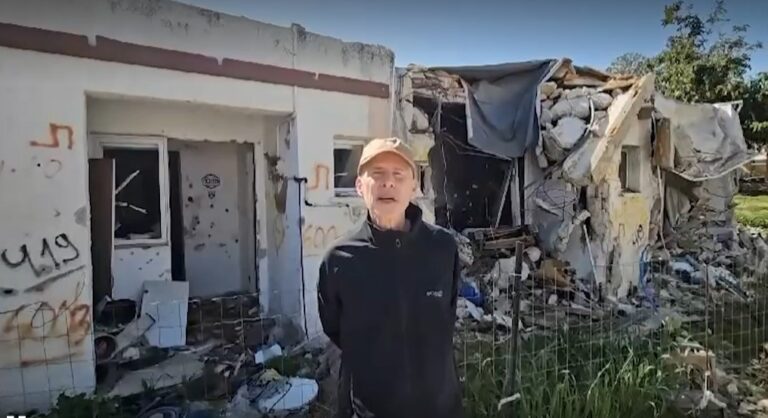 For the television reporter, clad in his red cagoule emblazoned with the CNN logo, it was a dramatic on-air moment, broadcasting live from Long Island, New York during a hurricane that also threatened Manhattan.
For the television reporter, clad in his red cagoule emblazoned with the CNN logo, it was a dramatic on-air moment, broadcasting live from Long Island, New York during a hurricane that also threatened Manhattan.
“We are in, right, now…the right eye wall, no doubt about that…there you see the surf,” he said breathlessly. “That tells a story right there.”
Stumbling and apparently buffeted by ferocious gusts, he took shelter next to a building. “This is our protection from the wind,” he explained. “It’s been truly remarkable to watch the power of the ocean here.”
The surf may have told a story but so too did the sight behind the reporter of people chatting and ambling along the sea front and just goofing around. There was a man in a t-shirt, a woman waving her arms and then walking backwards. Then someone on a bicycle glided past.
Across the screen, the “Breaking News: Irene Batters Long Island” caption was replaced by stern advice from the Federal Emergency Management Agency (FEMA): “Stay inside, stay safe.”
The images summed up Hurricane Irene – the media and the United States federal government trying to live up to their own doom-laden warnings and predictions while a sizeable number of ordinary Americans just carried on as normal and even made gentle fun of all the fuss.
There was almost palpable disappointment among the TV big guns rolled out for the occasion when Irene was downgraded to a mere ‘tropical storm”. In New York city, CNN’s silver-haired Anderson Cooper, more usually seen in a tight t-shirt in a famine or war zone, was clad in what one wag dubbed “disaster casual”.
He looked crestfallen and fell briefly silent when a weatherwoman told him that the rain was not going to get any worse. “Wow, because this isn’t so bad,” he said. “It’s an annoying rain but it isn’t even a sideways rain.”
Then came the press conferences from the politicians, with Governor Chris Christie of New Jersey insisting that his evacuation of the Jersey Shore was “a pre-emptive measure that I am confident saved lives” and there could still be damage worth “tens of billions” of dollars.
Janet Napolitano, the Homeland Security chief, declared that there was “a ways to go with Irene” but “with the evacuations and other precautions taken we have dramatically decreased the risk to life”. Mayor Michael Bloomberg of New York seemed thoroughly delighted with himself, as if he personally had calmed the waters and stifled the winds.
The truth is that the dire warning beforehand suited both politicians and journalists. Just as with the minor earthquake that shook the east coast last week causing no loss of life and virtually no damage, Irene became a huge story because it was where the media lived.
For politicians, Irene was a chance to either make amends or appear in control. The White House sent out 25 Irene emails to the press on Saturday alone.
There were photographs of President Barack Obama touring disaster centres and footage of him asking sombre, pertinent questions. With his poll ratings plummeting, Obama needed to project an aura of seriousness and command. He was all too aware that the political fortunes of his predecessor George W Bush never recovered after the Hurricane Katrina disaster of 2005.
The press mostly reported the message the White House had carefully crafted: “Obama takes charge” read the headline of one wire service story.
At the state level, Irene was a chance for political redemption. Christie had been lambasted around the start of the year for taking a holiday during one of the worst snow storms in New Jersey history.
Bloomberg, who ordered a mandatory evacuation of residents in low-lying areas during Irene that thousands ignored, had been widely criticised for inadequate clean-up plans during the same blizzards.
There was some loss of life during Irene, though significantly less than during dozens of other weather events across the US this year.
Preparation for the worst-case scenario makes sense and could have saved hundreds during Katrina. But the worst-case scenario was largely portrayed as inevitable. Some of the footage of television reporters putting themselves in the most extreme position possible just to get the best “stand-up” live shot was beyond parody.
First prize went to Tucker Barnes, a reporter for Fox 5, who went live from Ocean City, Maryland amid a strange, brown foamy substance. He reported that it “didn’t taste great” and had a “sandy consistency”. Apparently, it was raw sewage.
As Howard Kurtz notes, The media and politicians enjoy a symbiotic relationship during possible impending disasters. The resultant perfect storm of hype over Irene runs the risk of making Americans even more like to ignore warnings in the future.
By lunchtime on Sunday, the sun was peeking through over New York. The TV anchors were expressing their relief at the good news that the east coast had “dodged a bullet” and Irene had not been the apocalypse they had predicted.
Perhaps it would be a bit too much to hope that they and certain politicians felt a little sheepish too.
(Source: Telegraph UK)











8 Responses
If you looked at the forecast on Friday, it was clear that at most it would be a tropical storm when it hit New York, that it would come after Shabbos (no need to leave radios on or otherwise spoil Shabbos), and even if it followed the worst possible route (which it did) the damage to New York City would be anything but catastrophic.
Anyone for suggest the basic meteorology should be included in the school’s English curriculum.
Hype? Tell it to the families of the man who was electrocuted by downed wires or the family of the woman who drowned upstate or those whose property was destroyed by flodding and downed trees. When the city was woefully unprepared for a blizzard everyone wanted heads to roll. Now that that they prepared for the worst, which never came people are laughing. People are fickle.
The Blizzard was also no big deal and overhyped. There was nothing wrong with the city’s response to the blizzard, other than a media-hyped overreaction as well.
Why say it was hype? As believing Jews, we should say that it could have been a disaster R”L, but HaShem had rachmonus and saved us. If we don’t see yad HaShem, next time, chas v’shalom, we might not be so fortunate.
This article is both ignorant and dangerous, i guess a storm that killed at least 9, and 2 from our community is just Hype. I think Yeshiva World should use more judgment when reprinting articles from any source especially the Telegraph. It is the obligation of the government to be proactive; the media will always look to sensationalize every opportunity they have. From where I’m sitting this storm hit us very hard, how can a storm that cost us so much loss of life be viewed any other way.
I had no problem with the ‘hype’ after all G-d is in charge and not Bloomberg, Cuomo, or Christie. If He wanted the storm to skirt NC then exit stage right into the Atlantic, it would have done so. Here in NY we don’t have the same “feel” for Hurricanes that they do down south so it IS a big deal. Besides, there WAS damage, LOTS of damage!
I love these armchair quarterbacks whose hindsight is 20/20. If Irene had picked up speed over open water in between NC and NJ and the damage/death count had been much worse cv”s, these people wouldn’t be so snarky.
B”H those in charge had the foresight to organize evacuations in advance and send out plenty of warnings via the media. It’s too easy to look back and say it was too much.
So right wandering Chana, it COULD have been worse, but Hashem had pity on us. Expect the worse, pray for the best!! We still had to do our preparations AND hurricane season isn’t over yet!!